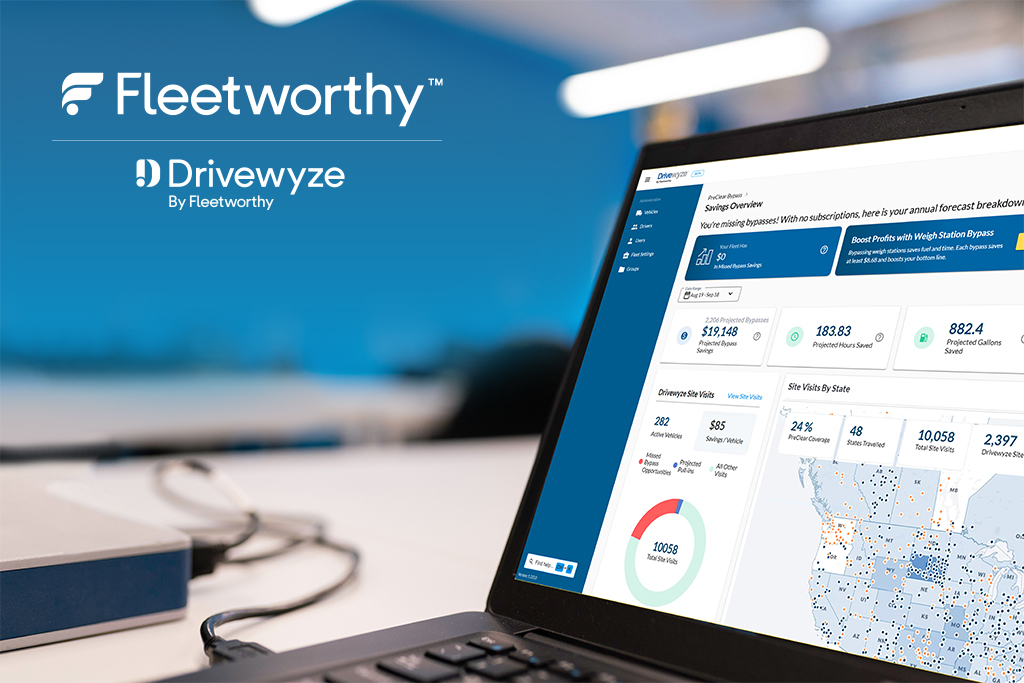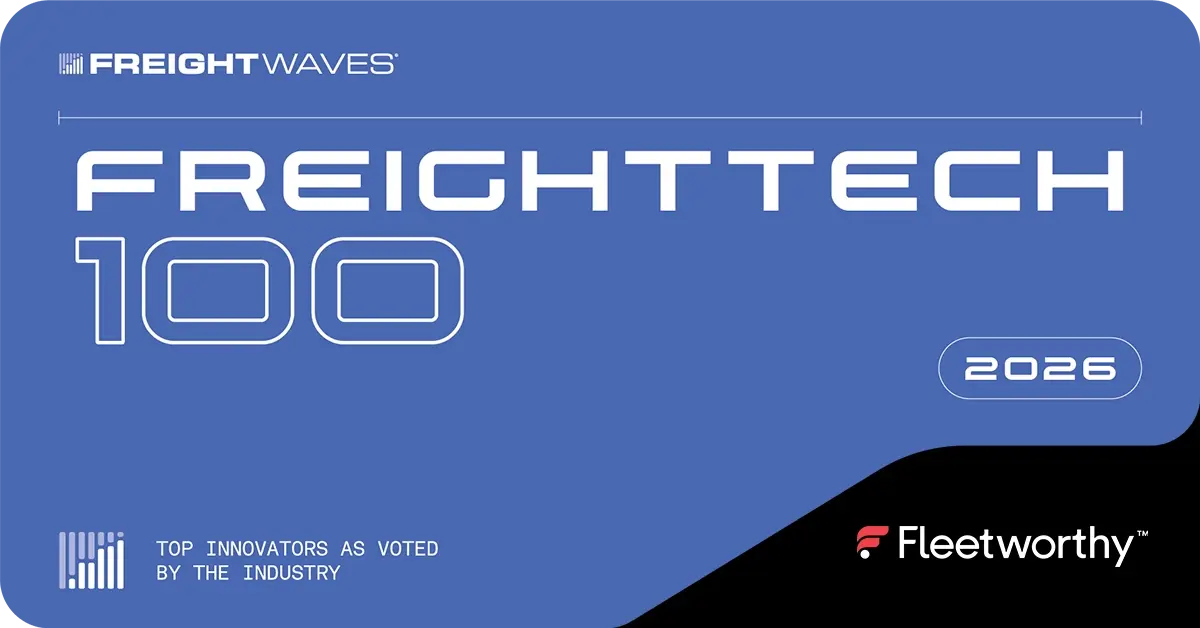Artificial intelligence (AI) has rapidly evolved from a futuristic concept into a powerful, practical tool driving innovation across nearly every industry. From healthcare and finance to manufacturing and logistics, AI is unlocking new levels of efficiency, automation, and decision-making accuracy. In the transportation sector, particularly within commercial fleets, AI is starting to play a crucial role in transforming how vehicles, drivers, and data are managed.
For fleet operators, the pressure to improve safety, reduce costs, maintain compliance, and meet increasingly high customer expectations has never been greater. Traditional fleet management systems, while effective to a point, are increasingly being outpaced by the complexity and scale of modern fleet operations. That’s where AI in fleet management comes in, offering innovative, data-driven solutions to long-standing challenges.
From real-time driver monitoring and predictive maintenance to automated compliance tracking and intelligent route optimization, AI fleet technologies are not only streamlining operations but also enhancing safety and long-term sustainability. As these technologies continue to mature, fleet managers who adopt AI early are gaining a strategic advantage through enhanced visibility, improved risk mitigation, and optimized performance.
In this article, we’ll explore the current applications of AI in fleet management, highlighting how it’s already transforming operations. We’ll also look ahead at the emerging potential of AI fleet solutions and what the future may hold for fleets that fully embrace this technological shift.
Understanding AI in Fleet Management
In the context of fleet management AI, artificial intelligence serves as the brain behind smarter, safer, and more efficient operations. It ingests vast amounts of data from vehicles, drivers, sensors, and external sources, such as traffic and weather, and then applies advanced algorithms to identify patterns, optimize decision-making, and deliver actionable insights in real time.
Core Components of AI Fleet Management
To understand the value AI brings to modern fleet operations, it’s essential to break down its foundational technologies:
- Machine Learning (ML): ML enables fleet systems to learn from historical and real-time data without requiring explicit programming. This is crucial for functions such as identifying high-risk driving patterns or predicting when a vehicle component is likely to fail.
- Computer Vision: This enables systems to “see” and interpret visual data from dashcams and onboard cameras. It’s commonly used for detecting distracted driving, lane departures, near-misses, and other safety-related behaviors.
- Predictive Analytics: Using historical trends and real-time inputs, predictive analytics helps forecast outcomes, whether it’s determining the optimal time for vehicle maintenance or anticipating a driver’s risk of a safety violation.
These components work in tandem to give fleet managers greater visibility and foresight than traditional systems ever could, making fleet management AI a powerful tool for proactive operations.
Why Fleets Are Adopting AI Now
Several key trends have accelerated the adoption of AI fleet management technologies:
- Data Proliferation: Telematics, ELDs, dashcams, and other digital systems now generate massive volumes of fleet data. AI is the only scalable way to interpret and leverage this data effectively.
- Safety and Compliance Pressures: With tighter FMCSA regulations, increasing liability risks, and rising accident costs, fleets are under growing pressure to improve safety and maintain compliance, areas where AI excels.
- Operational Complexity: As fleets scale and diversify, manual systems struggle to keep up with the pace. AI provides the adaptability and real-time intelligence needed to manage complex, dynamic operations.
- Technology Maturity: AI tools have become increasingly accessible, accurate, and affordable, particularly as cloud computing and edge devices have advanced in capability and cost-effectiveness.
In short, the convergence of necessity and technological capability is making AI a logical next step for fleets that want to stay competitive and compliant in a data-driven era.
Current Applications of AI Fleet Technologies
AI fleet technologies are not futuristic concepts; they’re already being applied today across multiple touchpoints in fleet operations. From behind the wheel to back-office compliance, fleet management AI is reshaping how safety, efficiency, and accountability are achieved. Below are key application areas where AI is currently making a measurable impact.
Driver Behavior Monitoring & Coaching
Modern AI fleet systems utilize machine learning and computer vision to monitor driver behavior in real-time, enabling fleets to proactively manage safety and performance.
- Real-Time Risk Detection: AI-powered dashcams and telematics systems detect unsafe driving behaviors, including harsh braking, rapid acceleration, sharp turns, speeding, and distracted driving. These systems can identify risk patterns before they result in collisions.
- Automated Driver Scoring: Data collected from on-road behavior is analyzed to generate driver safety scores. These scores provide objective insights that can be used for performance reviews, targeted coaching, and incentive programs.
- Behavioral Coaching and Alerts: Many ai fleet management platforms now offer in-cab alerts and post-trip summaries, allowing drivers to self-correct behaviors instantly or review feedback with a safety manager.
By combining AI with real-world data, fleets are creating safer driving environments while improving driver engagement and accountability.
Predictive Maintenance
Downtime is one of the costliest variables in fleet operations. Fleet management AI uses predictive analytics to keep vehicles on the road and out of the shop unnecessarily.
- Failure Forecasting: AI algorithms analyze engine diagnostics, mileage, part lifespan, and environmental conditions to predict when components, such as brakes, tires, or transmissions, are likely to fail before breakdowns occur.
- Maintenance Scheduling Optimization: Rather than relying on fixed service intervals, AI fleet systems recommend maintenance actions based on vehicle usage and condition, improving uptime and extending asset life.
- Cost Reduction: Proactive maintenance reduces emergency repair costs, prevents cascading failures, and improves warranty recovery, helping to lowerthe total cost of ownership (TCO).
This smart approach to vehicle health enables a more resilient, efficient, and cost-effective fleet.
Route Optimization & Fuel Efficiency
Efficient routing and fuel management have a direct impact on profitability and environmental compliance. AI is making significant advancements in both areas.
- Intelligent Routing: AI systems utilize real-time data, including traffic patterns, weather, road closures, vehicle load, and delivery windows, to determine the most efficient routes. These adaptive systems continually update recommendations based on changing conditions.
- Fuel Efficiency Insights: AI fleet management tools track fuel consumption patterns and correlate them with driver behavior, terrain, and route selection. Fleets can use these insights to reduce idling, optimize gear shifting, and improve MPG performance.
- Sustainability Gains: By reducing unnecessary miles and fuel usage, AI enables fleets to lower their carbon footprint and align with sustainability goals, which are often a requirement in modern RFPs and regulatory frameworks.
Safety & Risk Mitigation
One of the most powerful applications of ai fleet solutions is accident prevention and liability reduction.
- Advanced Driver Assistance Systems (ADAS): AI enhances safety systems, such as lane departure warnings, collision avoidance, and pedestrian detection. These systems alert drivers in real time and can even trigger automated braking in critical scenarios.
- Post-Incident Analysis: When a safety event or collision occurs, AI helps reconstruct the event using data from cameras, GPS, and vehicle sensors. This enables more accurate root-cause analysis and faster claims resolution.
- Risk Profiling: AI evaluates behavioral trends, location-based risks, and vehicle usage patterns to identify high-risk scenarios, allowing safety teams to intervene before an incident occurs.
The result is a measurable reduction in accident rates and improved control over risk exposure.
Compliance & Regulatory Automation
Staying compliant with DOT, FMCSA, and other regulations is complex and resource-intensive but fleet management AI is easing that burden through automation and real-time tracking.
- Driver Qualification File (DQF) Monitoring: AI tools can automatically track expiring documents, required training, medical certifications, and endorsements, reducing the risk of non-compliance during audits or roadside inspections.
- Hours of Service (HOS) Compliance: By integrating with ELDs, AI fleet systems can monitor HOS in real time, flagging violations before they happen and ensuring accurate logs for inspections.
- Audit Readiness and Reporting: AI helps maintain organized, up-to-date compliance records, while also generating reports that identify trends and opportunities for process improvement.
This automation not only simplifies compliance but also protects against costly fines, out-of-service violations, and reputational damage.
Benefits of Integrating AI Fleet Solutions
The growing adoption of AI in fleet management is not simply about keeping up with technological trends; it’s about unlocking tangible, measurable benefits that improve the bottom line, enhance safety, and create a more resilient operation. Below are the key benefits fleets are realizing through successful AI integration.
Improved Driver Safety and Retention
Safety is the cornerstone of any successful fleet, and AI-powered systems are transforming how safety is monitored, managed, and improved.
- Real-Time Intervention: AI provides immediate feedback on risky driving behaviors, helping to prevent accidents before they occur. Drivers are alerted to distractions, fatigue, or aggressive maneuvers as they occur, reducing the chances of collisions or near-misses.
- Targeted Coaching and Recognition: Driver performance data allows fleets to offer personalized coaching that’s grounded in objective analytics. At the same time, high-performing drivers can be recognized and rewarded, which improves morale and reduces turnover.
- Safer Work Environments: When drivers know they’re supported by advanced tools that prioritize their safety, they’re more likely to remain loyal to the organization. This creates a positive feedback loop that reinforces both safety and retention.
Reduced Operational Costs
AI doesn’t just make fleets smarter, it makes them leaner and more cost-effective.
- Maintenance Cost Savings: Predictive maintenance reduces the risk of unexpected breakdowns, allowing fleets to avoid emergency repair costs and extend the lifespan of critical components.
- Fuel Efficiency Gains: Smarter routing and behavior-based feedback can significantly reduce fuel consumption. AI analyzes route choices, idling time, acceleration patterns, and other variables to fine-tune fuel efficiency across the entire fleet.
- Administrative Efficiency: AI automates many time-consuming tasks, such as compliance tracking, report generation, and data auditing, thereby reducing labor hours and freeing up staff to focus on strategic priorities.
When applied at scale, these efficiencies can yield substantial savings in both direct and indirect costs.
Enhanced Compliance Confidence
Navigating the complexities of regulatory compliance is one of the most resource-intensive aspects of fleet management. AI in fleet management is streamlining this process and giving operators peace of mind.
- Real-Time Monitoring: AI-integrated systems continuously track compliance metrics such as Hours of Service, vehicle inspections, and DQF status, proactively flagging issues so fleets can address them before violations occur.
- Documentation Automation: From ELD logs to medical certification alerts, AI ensures critical documentation is accurate, up-to-date, and ready for audits.
- Reduced Risk of Violations: With more intelligent alerts and automated workflows, AI minimizes human error, thereby reducing the likelihood of fines, citations, or out-of-service orders that can disrupt operations and damage reputations.
This level of control and transparency allows fleets to operate with confidence in an increasingly regulated environment.
Data-Driven Decision-Making and Fleet Visibility
Perhaps one of the most transformative aspects of AI integration is the ability to turn raw data into actionable intelligence.
- Centralized Dashboards: AI fleet platforms consolidate data from multiple sources, including telematics, maintenance systems, compliance tools, and cameras, into unified dashboards that provide a real-time snapshot of fleet health and performance.
- Predictive Insights: AI doesn’t just report what’s happening, it helps forecast what will happen. Whether it’s identifying which drivers are most at risk or which vehicles are nearing a maintenance threshold, AI enables more strategic planning and risk management.
- Smarter Business Decisions: From scaling operations to optimizing routes and adjusting driver schedules, AI supports decisions that are faster, more accurate, and more aligned with key business goals.
By embracing AI in fleet management, organizations are shifting from reactive problem-solving to proactive strategy execution.
Challenges and Limitations
While the advantages of AI in fleet management are significant, adopting these technologies isn’t without hurdles. Fleets need to navigate a range of operational, technical, and cultural challenges to successfully integrate AI into their workflows. Understanding these barriers is essential for developing a realistic implementation plan and setting proper expectations.
Data Privacy and Ethical Concerns
One of the most pressing issues in adopting AI systems is data privacy, especially when it comes to monitoring drivers. AI-powered tools collect vast amounts of personal and behavioral data through dashcams, telematics, and mobile applications. This raises concerns among drivers about how their data is used, who has access to it, and how it may affect their employment.
To address this, fleets must establish transparent data policies and ensure compliance with privacy regulations, such as the GDPR or state-specific laws. Ethical use of AI also means clearly communicating how data is used, for example, to improve safety or reduce risk, not to unfairly penalize drivers. Without this trust, even the most advanced AI system can create resistance and morale issues.
Integration with Legacy Systems
Many fleets operate with a patchwork of legacy software, disconnected databases, and outdated hardware. Integrating AI solutions into these environments can be technically challenging, especially when real-time data sharing or automation is involved.
Some AI platforms are designed to be plug-and-play, but others require API development, cloud migration, or system overhauls. The transition can be costly and time-consuming, especially for fleets that lack in-house IT expertise. In such cases, careful planning and vendor collaboration are crucial to minimize disruptions and ensure a seamless integration process.
Initial Investment Costs
Despite the long-term savings and ROI potential, AI solutions often require upfront investment in both software and hardware. This might include purchasing new telematics devices, dashcams with AI capabilities, cloud storage, and training programs. For small and mid-sized fleets, these costs can be a significant barrier to adoption.
However, as AI in fleet management becomes more widespread, costs are gradually decreasing, and many providers now offer flexible pricing models, such as subscriptions or usage-based billing. Still, organizations must weigh initial expenses against the operational improvements and risk reduction AI offers.
Change Management and Driver Adoption
Technology alone doesn’t drive transformation; people do. Even the best AI solution can fail if it isn’t supported by those expected to use it. Change management is often one of the most underestimated challenges in AI adoption.
Drivers may view AI monitoring as invasive, while managers may struggle to interpret or act on new data streams. To overcome this, fleets must invest in training, communication, and user-friendly tools that clearly demonstrate how AI benefits everyone, not just the bottom line, but also safety, job security, and operational ease.
Fleets that involve drivers and frontline staff early in the rollout process tend to see stronger adoption rates and more sustained success.
The Future of AI in Fleet Management
As fleets grow more connected, data-rich, and safety-conscious, the next evolution of AI fleet technologies is already underway. While current applications have delivered significant improvements in safety, efficiency, and compliance, the future of AI fleet management promises to be even more transformative, driven by deeper automation, more innovative predictive systems, and seamless platform integration.
Predictive Safety Analytics and Autonomous Vehicle Integration
The next wave of fleet safety will rely heavily on AI’s predictive capabilities. Rather than reacting to incidents or violations, future systems will anticipate them before they occur, alerting managers to high-risk drivers, routes, or environmental factors.
These predictive analytics will extend beyond individual behavior scoring to include fleet-wide risk forecasting. Combined with sensor-rich vehicles and real-time traffic data, AI will be able to model the likelihood of crashes or mechanical failures across entire regions or fleets, enabling preemptive intervention.
At the same time, autonomous vehicle technology is gradually being integrated into commercial transportation. As autonomy evolves from advanced driver assistance systems (ADAS) to fully self-driving vehicles, AI will become the foundation for everything from route decisions to obstacle detection. For early adopters, AI will serve as the co-pilot, reducing driver workload, boosting fuel efficiency, and lowering accident rates through continuous, automated oversight.
AI-Driven Insurance Underwriting and Risk Profiling
As insurance carriers seek to better quantify and mitigate fleet risk, AI fleet management systems will play a central role in shaping new underwriting models. Real-time driver data, behavioral insights, and predictive maintenance records can give insurers a far more accurate risk profile than traditional demographic or historical loss data.
This could lead to dynamic insurance pricing based on actual fleet performance, not just assumptions or broad actuarial categories. Fleets demonstrating proactive use of AI safety tools may benefit from premium discounts, while those neglecting risk mitigation efforts could face higher rates.
Ultimately, AI will empower a more equitable and performance-based approach to commercial fleet insurance, aligning financial incentives with safety investments.
Integrated Fleet Ecosystems
In the near future, standalone platforms for routing, maintenance, compliance, safety, and driver management will give way to fully integrated fleet ecosystems, all powered by AI. These unified systems will centralize operational data, streamline decision-making, and allow for automated workflows that reduce manual tasks and information silos.
For example, a safety alert triggered by a near-miss could automatically notify a driver coach, schedule vehicle diagnostics, and update the driver’s risk score, all without human input. Compliance violations can be automatically addressed through triggered reminders, policy updates, or training modules, thereby closing the loop between detection and resolution in real-time.
This level of end-to-end automation will be driven by AI’s ability to process vast amounts of data from multiple inputs and deliver context-specific actions across all areas of the fleet.
The Rise of Generative AI in Back-Office Operations
Beyond the cab and the vehicle itself, generative AI is emerging as a force multiplier in back-office fleet management. These advanced models can automate content creation, streamline reporting, and even support complex decision-making.
Imagine AI tools generating maintenance reports, customizing safety policies, summarizing compliance audit findings, or drafting fleet communications based on natural language prompts or structured data inputs. Fleet managers could use generative AI to simulate “what-if” scenarios, forecast budgets, or design new operational workflows.
This shift will allow teams to focus on high-value strategic tasks, while AI handles the repetitive, administrative, and analytical functions that consume time but deliver limited insight without automation.
Conclusion
Artificial intelligence has firmly established itself as a transformative force in the world of fleet operations. From real-time driver behavior monitoring and predictive maintenance to intelligent route planning and automated compliance, AI in fleet management is delivering measurable improvements in safety, efficiency, and cost control.
As the industry continues to evolve, AI is no longer a luxury reserved for large-scale fleets; it has become a necessity for any operation that wants to remain competitive, compliant, and future-ready. The rapid pace of innovation, combined with increasing regulatory and customer expectations, makes forward-thinking adoption essential.
Fleets that embrace AI today will be better positioned to harness tomorrow’s opportunities from autonomous technologies and insurance optimization to fully integrated, AI-powered fleet ecosystems.
Now is the time to assess your current systems, identify gaps, and evaluate your fleet’s readiness for AI integration. Whether you’re just beginning the journey or looking to scale existing tools, the future of fleet management is undeniably intelligent, and the fleets that act now will lead the way.
Frequently Asked Questions (FAQ)
What is AI in fleet management?
AI in fleet management refers to the use of artificial intelligence technologies, such as machine learning, computer vision, and predictive analytics, to automate, optimize, and enhance various aspects of fleet operations. These systems process vast amounts of data from vehicles, drivers, and sensors to provide real-time insights, automate decision-making processes, and enhance safety, efficiency, and compliance.
How does AI improve fleet safety?
AI improves fleet safety by continuously monitoring driver behavior, vehicle conditions, and environmental factors. AI fleet systems can detect unsafe actions, such as harsh braking, distracted driving, or speeding, in real-time and provide instant feedback to the driver. Over time, this helps fleets reduce collisions, identify high-risk behaviors, and implement targeted coaching strategies that ultimately lead to safer operations.
What are the top AI tools used in fleet operations?
Some of the most common AI tools in fleet management AI include:
- AI-powered dashcams for driver monitoring
- Predictive maintenance platforms
- Route optimization engines
- Compliance automation systems for ELDs and DQFs
- Integrated safety and risk analytics platforms
These tools work together to provide a comprehensive, data-driven approach to managing modern fleets.
Can AI help with DOT compliance?
Yes, AI in fleet management can significantly ease the burden of DOT and FMCSA compliance. AI systems automatically track Hours of Service (HOS), maintain Driver Qualification Files (DQFs), and flag potential violations before they occur. They also help keep documentation audit-ready by ensuring that all records are accurate, current, and accessible in real-time.
Is AI worth the cost for small or mid-size fleets?
Absolutely. While the initial investment in AI fleet technology may seem high, small and mid-sized fleets often see a strong return on investment through reduced fuel costs, fewer safety incidents, lower maintenance expenses, and improved compliance. Many providers now offer scalable, subscription-based solutions, making AI fleet management more accessible and cost-effective for fleets of all sizes.




